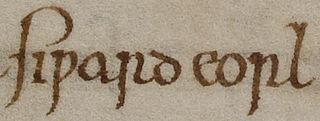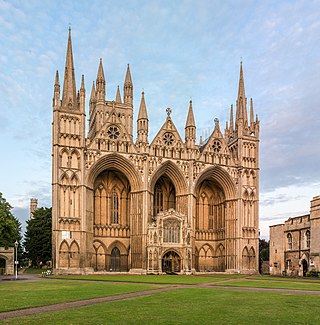Contents
| Other decades |
| 1030s | 1040s | 1050s | 1060s | 1070s |
Events from the 1050s in England .
| Other decades |
| 1030s | 1040s | 1050s | 1060s | 1070s |
Events from the 1050s in England .

Ealdred was Abbot of Tavistock, Bishop of Worcester, and Archbishop of York in early medieval England. He was related to a number of other ecclesiastics of the period. After becoming a monk at the monastery at Winchester, he was appointed Abbot of Tavistock Abbey in around 1027. In 1046 he was named to the Bishopric of Worcester. Ealdred, besides his episcopal duties, served Edward the Confessor, the King of England, as a diplomat and as a military leader. He worked to bring one of the king's relatives, Edward the Exile, back to England from Hungary to secure an heir for the childless king.

1055 (MLV) was a common year starting on Sunday of the Julian calendar.
Godwin of Wessex was an Anglo-Saxon nobleman who became one of the most powerful earls in England under the Danish king Cnut the Great and his successors. Cnut made Godwin the first Earl of Wessex. Godwin was the father of King Harold II and of Edith of Wessex, who in 1045 married King Edward the Confessor.

Edward the Confessor was an Anglo-Saxon English king and saint. Usually considered the last king of the House of Wessex, he ruled from 1042 until his death in 1066.

Earl is a rank of the nobility in the United Kingdom. In modern Britain, an earl is a member of the peerage, ranking below a marquess and above a viscount. A feminine form of earl never developed; instead, countess is used.

Gruffydd ap Llywelyn was King of Gwynedd and Powys from 1039 and, after asserting his control over the entire country, claimed the title King of Wales from 1055 until his death in 1063. He was the son of Llywelyn ap Seisyll king of Gwynedd and Angharad daughter of Maredudd ab Owain, king of Deheubarth, and the great-great-grandson of Hywel Dda. Gruffydd was the first and only Welsh king to unite all of Wales albeit for a brief period. After his death, Wales was again divided into separate kingdoms.
Robert of Jumièges was the first Norman Archbishop of Canterbury. He had previously served as prior of the Abbey of St Ouen at Rouen in Normandy, before becoming abbot of Jumièges Abbey, near Rouen, in 1037. He was a good friend and adviser to the king of England, Edward the Confessor, who appointed him bishop of London in 1044, and then archbishop in 1051. Robert's time as archbishop lasted only about eighteen months. He had already come into conflict with the powerful Earl Godwin and, while archbishop, made attempts to recover lands lost to Godwin and his family. He also refused to consecrate Spearhafoc, Edward's choice to succeed Robert as Bishop of London. The rift between Robert and Godwin culminated in Robert's deposition and exile in 1052.
Earl of Hereford is a title in the ancient feudal nobility of England, encompassing the region of Herefordshire, England. It was created six times.

Leofric was an Earl of Mercia. He founded monasteries at Coventry and Much Wenlock and was a very powerful earl under King Cnut and his successors. Leofric was the husband of Lady Godiva.

Siward or Sigurd was an important earl of 11th-century northern England. The Old Norse nickname Digri and its Latin translation Grossus are given to him by near-contemporary texts. It is possible Siward may have been of Scandinavian or Anglo-Scandinavian origin, perhaps a relative of Earl Ulf, although this is speculative. He emerged as a regional strongman in England during the reign of Cnut. Cnut was a Scandinavian ruler who conquered most of England in the 1010s, and Siward was one of many Scandinavians who came to England in the aftermath, rising to become sub-ruler of most of northern England. From 1033 at the latest, he was in control of southern Northumbria, present-day Yorkshire, governing as earl on Cnut's behalf.

Ælfgar was the son of Leofric, Earl of Mercia, by his famous wife Godgifu. He succeeded to his father's title and responsibilities on the latter's death in 1057. He gained the additional title of Earl of East Anglia, but also was exiled for a time. Through the first marriage of his daughter he became father-in-law to Welsh king Gruffydd ap Llywelyn, a few years after his death, his daughter became a widow and married the English King Harold.
Sweyn Godwinson, also spelled Swein, was the eldest son of Earl Godwin of Wessex, and brother of Harold II of England.
Eadsige, was Archbishop of Canterbury from 1038 to 1050. He crowned Edward the Confessor as king of England in 1043.

Ralph the Timid, also known as Ralf of Mantes, was Earl of Hereford between 1051 and 1055 or 1057. His mother was Godgifu, the daughter of King Æthelred the Unready and his second wife Emma. His father was Drogo of Mantes, Count of Valois and the Vexin, who died on pilgrimage to Jerusalem in 1035.
The Earls of East Anglia were governors of East Anglia during the 11th century. The post was established by Cnut in 1017 and disappeared following Ralph Guader's participation in the failed Revolt of the Earls in 1075.
Events from the 1060s in England.
Events from the 1040s in England.

The House of Godwin was an Anglo-Saxon family who were one of the leading noble families in England during the last fifty years before the Norman Conquest. Its most famous member was Harold Godwinson, King of England for nine months in 1066.
Ealdgyth, also Aldgyth or Edith in modern English, was a daughter of Ælfgar, Earl of Mercia, the wife of Gruffudd ap Llywelyn, ruler of all Wales, and later the wife and queen consort of Harold Godwinson, king of England in 1066. She was described by William of Jumièges as a considerable beauty.
The Northumbrian Revolt of 1065 was a rebellion in the last months of the reign of Edward the Confessor against the earl of Northumbria, Tostig Godwinson, brother of Harold Godwinson, Earl of Wessex. Tostig, who had been earl since 1055, is said to have provoked his nobles to rise against him by his harsh administration of justice, raising of tax levels, frequent absences from his earldom, and murder of several political opponents. In October 1065 the rebels entered Northumbria's capital, York, killed Tostig's men, looted his treasury, renounced their allegiance to Tostig and proclaimed Morcar, brother of Edwin, Earl of Mercia, as their new earl. They then marched south to Northampton, causing much devastation in Yorkshire and the North Midlands as they went, and joining forces with the army of Mercia. The king sent his chief earl, Harold Godwinson, to negotiate with them, and when they refused to compromise on the deposition of Tostig he tried and failed to raise his own army against them. On Harold's advice, he finally gave in to their demands and recognised Morcar. Tostig was sent into exile in Flanders, from where, disgusted at what he saw as his brother's betrayal, he shortly afterward raided the English coast, finally dying in arms against him at the Battle of Stamford Bridge.